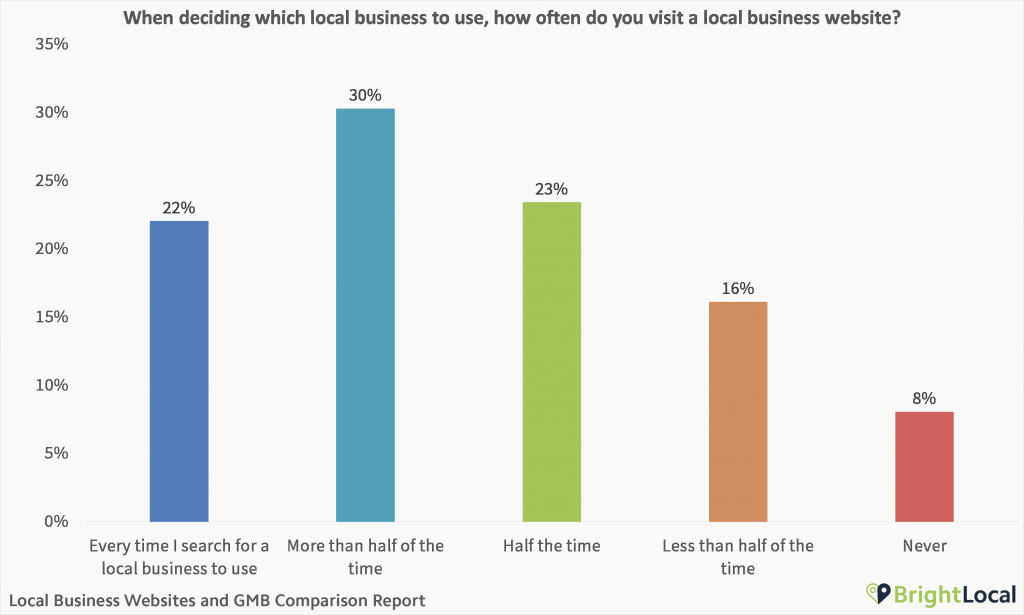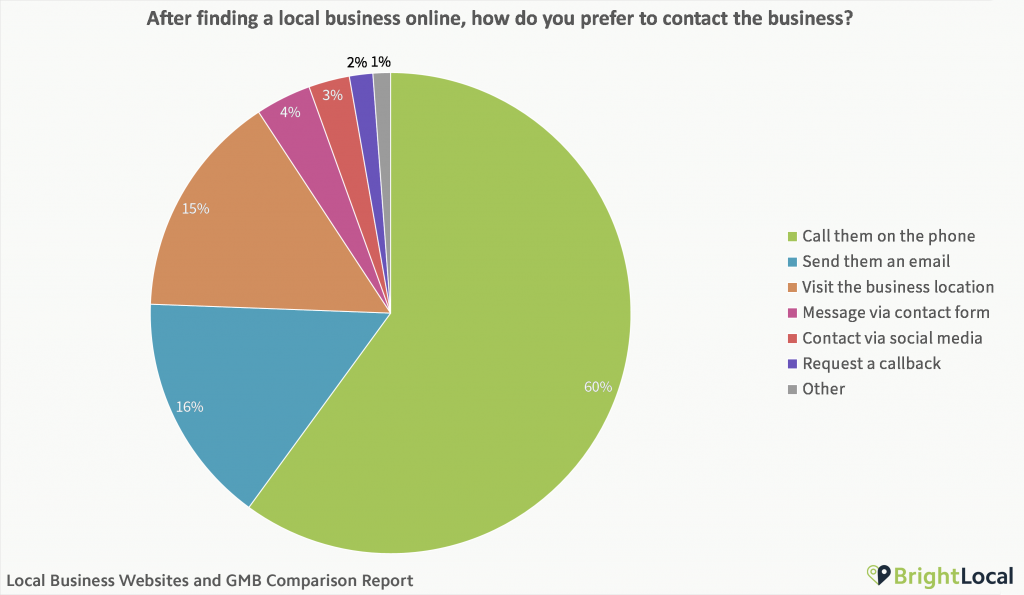- Consumers trust details from local business websites more than Google My Business or online directories
- 64% of consumers have used Google My Business to find contact details for local businesses
- The GMB features consumers are most likely to have used: 1. Opening hours, 2. Directions, and 3. Reading reviews
- Only 8% of consumers never look at websites when choosing which local business to use
- 50% of consumers would be deterred from using a local business if contact information was out of date on their website
Local businesses are lucky to have a wide range of local SEO tools at their disposal to help maximize their chances of being noticed online by potential customers. But, with Google My Business adding more features for local businesses all the time, you could be forgiven for assuming local businesses no longer need to dedicate time to ranking their websites.
We wanted to find out how consumers use Google My Business listings, local business websites, and business directories to find information about local businesses – and to discover which sources of information are most trusted among consumers.
To do this, we asked an independent panel of 500 US-based consumers to share their opinions around using Google My Business and businesses’ own websites to choose and interact with local businesses.
If you have any thoughts or questions on the report’s findings, let us know in the comments below, or get in touch.
Which local business types have you searched Google for?
Most Commonly Searched-for Local Businesses
1. Restaurants and Cafés (56%)
2. Grocery stores (37%)
3. Clothing stores (34%)
4. Hotels and B&Bs (34%)
5. Medical practices and healthcare (28%)
Consumers were asked which of 28 industries they had searched for using Google. While 87% of the respondents had used Google to find businesses, there were marked differences between industries.
The average respondent recalled making local Google searches for five different industries. Interestingly, every single industry had been searched for by a number of respondents, showing how important having a solid presence in local search results is for every industry.
As with the Local Consumer Review Survey, restaurants and cafés are the industries most likely to be viewed by consumers online. Of course, discovering a new restaurant to visit at home or on holiday is a common (and enjoyable) occurrence for many, and thus consumers may be more likely to remember doing so.
Less frequently-needed industries such as senior living services, in-home care, and childcare are likely to be searched by a smaller proportion of people.
Which sources have you used to find a local business’s phone number or address?
- 64% of consumers have used Google My Business listings to find a local business’s address or phone number
- 87% of consumers have looked for a phone number or address online
- 49% of consumers visit local business websites to find contact details
The vast majority of the consumers (87%) have looked for a local business’s phone number or address online.
Consumers are a little more likely to find contact details in GMB in SERPs than they are in Maps. When combining this data, the vast majority who’d used it in Maps had also done so in SERPs. The survey found that 64% of consumers have used Google My Business to find a business’s contact details. This means a significant number of businesses receive warm leads contacting them, without ever hitting their website.
But that’s not to say websites are no longer important. Half of the respondents recalled visiting a local business website to find contact details – with others likely to visit for other information.
But it’s not enough to ensure local business websites and GMB listings are up-to-date, as 23% of respondents had also visited an online business directory to seek an address or phone number.
Which source do you expect to have the most accurate and up-to-date contact information?
- 56% of consumers expect local businesses’ websites to have the most accurate contact information
- 32% believe Google My Business has the most accurate information
- 12% trust directories to have the most up-to-date information
Consumers were asked which online source they believed has the most accurate information – and we were surprised to see such a split.
While the majority trust websites to have the best data, a significant proportion of people prefer other sources. 32% trust Google My Business listings over the business’s website itself, meaning that 44% of consumers trust other sources more than the local business’s own website!
Clearly, GMB is gospel for those who are already using it, and with this high level of trust, local businesses need to make sure they’re being as trustworthy with the rest of their listing, avoiding spammy techniques such as fake reviews, name-stuffing, or ineligible listings.
With many consumers now looking beyond websites, it’s critical that local businesses have their contact details correct and consistent across the web. For more information on the importance of building accurate citations, take a look at our local citations hub.
Which features of Google My Business have you used?
Most Popular Google My Business Features
1. Checked opening hours
2. Found directions
3. Read reviews
4. Visited the business’s website
5. Looked at photos of a business
6. Booked a hotel room
7. Viewed a business’s Popular Times
8. Booked a table in a restaurant
9. Called a business using the ‘Call’ button
10. Left a review
Working in the local marketing space, it’s easy to assume that useful features of Google My Business are as important to consumers as they should be to local businesses. But, it appears many features remain underused by local consumers.
The GMB features that are most commonly used by consumers tend to be passive. Checking opening hours, finding directions, and reading reviews tend to be far more common than ‘active’ actions, such as editing listings, adding photos, and answering questions.
Perhaps some of those doing the more ‘active’ actions may be familiar with local business marketing, or encouraged to contribute by Google’s Local Guides programme.
Many of the most popular Google My Business actions don’t involve customers interacting directly with businesses. But, those checking opening hours, directions, or reading reviews are likely to be further in the buyer journey – with local businesses unaware they have such a warm lead until they do make contact. This means it’s crucial that GMB listings have as much information as possible, with up-to-date opening hours, images, and responses to customers.
In our Google My Business Insights Study, we found that the average local business has 11 photos, with hotels having an average of 150. Understanding what is ‘normal’ in your industry and among your peers is the first step toward making your GMB presence better than your competitors. You can run a simple Google My Business Audit to check how you’re doing.
Google Q&A has the potential to be one of the most useful features of GMB, but is criminally underused by consumers and local businesses alike. ThriveHive released interesting research into the response rates in Q&A, finding that only 62% of Questions were answered, with only 12% answered by the business itself. Perhaps if businesses were to promptly respond to every Question, and add their FAQs into this feature, consumers may be more inclined to use it.
When deciding which local business to use, how often do you visit a local business website?
- 22% of consumers check websites every time they are deciding on a local business
- 76% look at local business websites at least half of the time
- Only 8% of consumers never look at websites when choosing a business
Despite the wide usage and usefulness of Google My Business by consumers, there’s still a clear demand for local business websites. Only 8% of consumers never visit websites when choosing a local business.
Google My Business listings don’t contain the rich details that a local business website does. Listings are incredibly useful for those who are already aware of the business, or are in the decision-making process. But, those who really want to find out about a business’s unique offering often need to head to the website for more information.
Websites and GMB listings should complement each other – with websites providing details such as company details, images, and product details that just don’t fit on a listing. Websites hold the opportunity to rank highly for a number of keywords, as well as to demonstrate what makes a business better than its competitors.
When looking at websites, what would make you less likely to use a local business?
Biggest Errors on Local Business Websites
1. Out-of-date contact information
2. Poorly written content and typos
3. Out-of-date pricing information
4. Lack of prices
5. Difficult to find in search results
Consumers were asked which of a series of situations would deter them from using a business. The vast majority (91%) would be put off by at least one of the above situations.
Out-of-date contact information would stop half of consumers from using a local business. Considering how many consumers use local websites to find phone numbers and address, this could mean a significant proportion would be put off. People want accurate details so that they can easily continue their journey, so businesses need to ensure they remove any blockers.
It’s interesting that so many customers would be discouraged by a poorly written website. Local marketing budgets often don’t stretch to professional content services, but it’s important to ensure a website appears as professional as the brand does.
Images are an important part of choosing a local business for many consumers, with 34% looking at photos on GMB, and 29% being deterred from using a business if there weren’t images on the site. Including images of products, services, and the business can give a real flavor of what customers should expect.
After finding a local business online, how do you prefer to contact the business?
Top Sources of Contact
1. Phone call
2. Email
3. Visit the business location
4. Message via contact form
5. Contact via social media
Interestingly, the vast majority of consumers prefer to call local businesses. In fact, this has grown since we asked the same question back in 2016 – where 41% preferred calls, 20% emails, and 19% visiting the business.
Of course, as consumers were asked their sole preference, it’s no surprise calls come out on top. While some local businesses are responsive via email and social channels, this is by no means standard.
If a consumer has called a business, it’s pretty likely they’re already keen on using it. This time should be used to close more deals, finding out as much information as you can, demonstrating the business’s personality, and giving callers the customer service that you’d want them to receive if they were to visit the business.
Calls tend to lead to instant answers for consumers, so to make the most of calls, local business owners need to:
- Check phone numbers are correct and consistent across the website and local business websites
- Ensure they are sufficiently staffed to answer calls, with answerphone services outside of hours
- Consider using call tracking numbers to understand where calls are coming from
- Train staff on customer service and converting leads over the phone
- Explore how new tech such as Google’s CallJoy could free up employees
What are your experiences of using Google My Business listings and local business websites for clients? Let us know your successes, failures, and thoughts on the future below.








